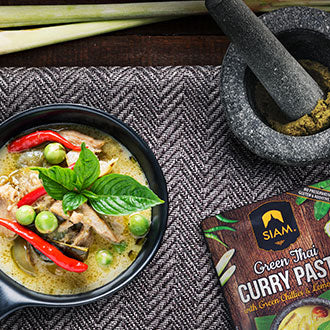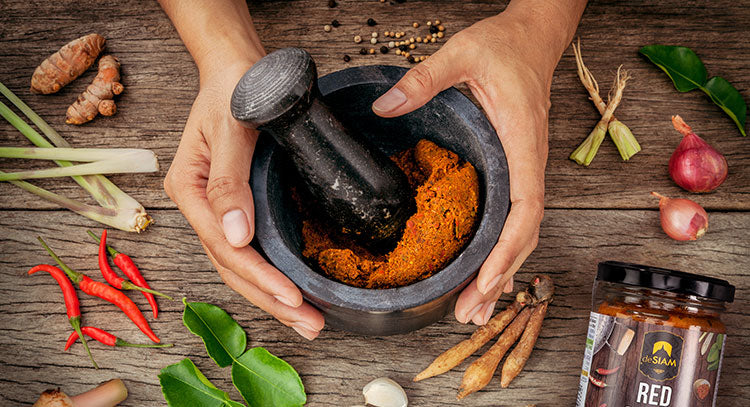My shopping cart
Your cart is currently empty.
Continue Shopping
The heart of the Thai kitchen is the mortar and pestle (known as Kork and Sak). Standing as iconic symbols of culinary tradition, revered for their ability to infuse dishes with authentic flavors.
From the vibrant hues of Thai curry pastes to the aromatic blends of freshly ground spices, mastering the use of these traditional tools can significantly enhance your culinary prowess. Let's delve into the art of choosing the perfect mortar and pestle and understanding their adept use.

As you observe the rhythmic pounding of ingredients in a mortar and pestle, it feels like the aromas and flavors are being released into the air. This traditional technique of grinding and crushing ingredients unlocks the natural oils and essences, resulting in a depth of flavor that modern kitchen appliances can't reproduce.
The mortar and pestle act as catalysts, breaking down the cell walls of herbs, spices, and vegetables, releasing their hidden aromas and intensifying their flavors. The texture of the ingredients is transformed, creating a harmonious blend that forms the backbone of many Thai dishes.
Thai kitchens make use of two main types of mortar and pestle: the granite mortar and pestle, and the terracotta mortar with a hardwood pestle. Each material has its own advantages and suitability for different types of ingredients and recipes.

Granite Mortar and Pestle
Benefits: The granite mortar and pestle, crafted from sturdy igneous rock, excels in durability and robustness. Its weight and solid construction handle vigorous grinding, perfect for making curry pastes and blending spices efficiently. Its strength ensures thorough blending, crucial for recipes like Thai green curry paste.
With varying sizes and capacities, it's versatile for different batch sizes, from condiments to nut butter. Its hefty build ensures stability during use, minimizing tipping or slipping, and the weight aids in the grinding process, making it easier for the user.
The downsides: Their weight may pose challenges for handling and cleaning, particularly for those with limited mobility or strength. Furthermore, being porous, granite tends to absorb liquids and odors, rendering it less suitable for grinding pungent ingredients such as fish.

Terracotta Mortar and Pestle
The benefits: The terracotta mortar and pestle, also known as the Laos-style mortar, offers an affordable and lightweight alternative to granite. Crafted from durable baked clay, it's perfect for lighter grinding and mixing tasks like crushing garlic or blending chili oil. Its affordability and manageable weight make it accessible to cooks of various skill levels.
Specifically designed for bruising and light mixing, it preserves delicate textures in dishes such as green papaya salad or nam prik chili paste. For those seeking textured dishes, this set is an excellent choice. Its deep bowl is excellent for creating marinades, spice rubs, and vinaigrette dressings.
The downsides: Their fragility in comparison to granite sets means that excessive force during grinding should be avoided. Furthermore, the pastes or mixtures crafted in a terracotta mortar might not achieve the same level of smoothness as those from a granite mortar.
Granite or Terracotta: Which is Right for You?
The choice between a granite and terracotta mortar and pestle ultimately depends on your preferences and cooking style.
Granite sets are perfect for those who enjoy making authentic Thai curry pastes and grinding spices. Terracotta sets, on the other hand, are great for those who prefer recipes that require gentle mixing or bruising of ingredients.
Before using
Wash your mortar and pestle by rinsing it thoroughly with warm water, ensuring all surfaces are clean. While soap or dishwashing liquid can be used, ensure a thorough rinse afterward. For granite sets, soak them in clean water for 2-3 hours, then let them air dry completely in the sun.
As for Terracotta sets, clean them thoroughly, let them air dry in the sun, and then proceed to cure them.
To cure your tools, use rice to grind away any remaining grit and impurities. Add a small handful of white rice and a tablespoon of water to the mortar, then use the pestle to grind the rice in circular motions. This action will create a gray paste as the rice absorbs any dirt or debris. Rinse out the paste with water and repeat the process until the rice paste comes out white and clean.
How to use
Here are some tips for using your mortar and pestle effectively:


After using your mortar and pestle, it's crucial to clean and store them properly to maintain longevity and prevent any lingering odors from affecting your next cooking session.
Rinse the set with warm water and, if needed, use soap or a brush to eliminate residue or stains. Thoroughly air dry the set after wiping away any excess water. Ensure they are completely dry before storing in a dry place to prevent mold growth or unpleasant odors.

Below are some traditional Thai recipes that truly come to life when prepared using a mortar and pestle:
Thai Curry Paste: Authentic Thai curry paste is a complex blend of herbs, spices, and aromatics. A curry paste requires a fine blend of herbs and spices, and mortar and pestle help you create a paste that captures the vibrant flavors and enticing aromas of Thai cuisine.
Som Tam (Green Papaya Salad): Som Tam is a quintessential Thai dish known for its vibrant flavors and textures. Using a mortar and pestle to prepare the dressing allows the ingredients to meld together, creating a harmonious balance of sweet, sour, and spicy flavors. The gentle pounding action of the pestle lightly bruises the ingredients, releasing their juices and enhancing the overall taste.
Nam Prik (Thai Chili Paste): Thai chili paste is a versatile condiment that adds a fiery kick to any dish. You can create a paste with the perfect blend of heat and flavor, tailored to your preference.
Tom Kha Gai Soup: This Thai coconut chicken soup is a comforting and aromatic dish. Using a mortar and pestle to create a paste infuses the broth with a depth of flavor, making each spoonful a delight for the senses.